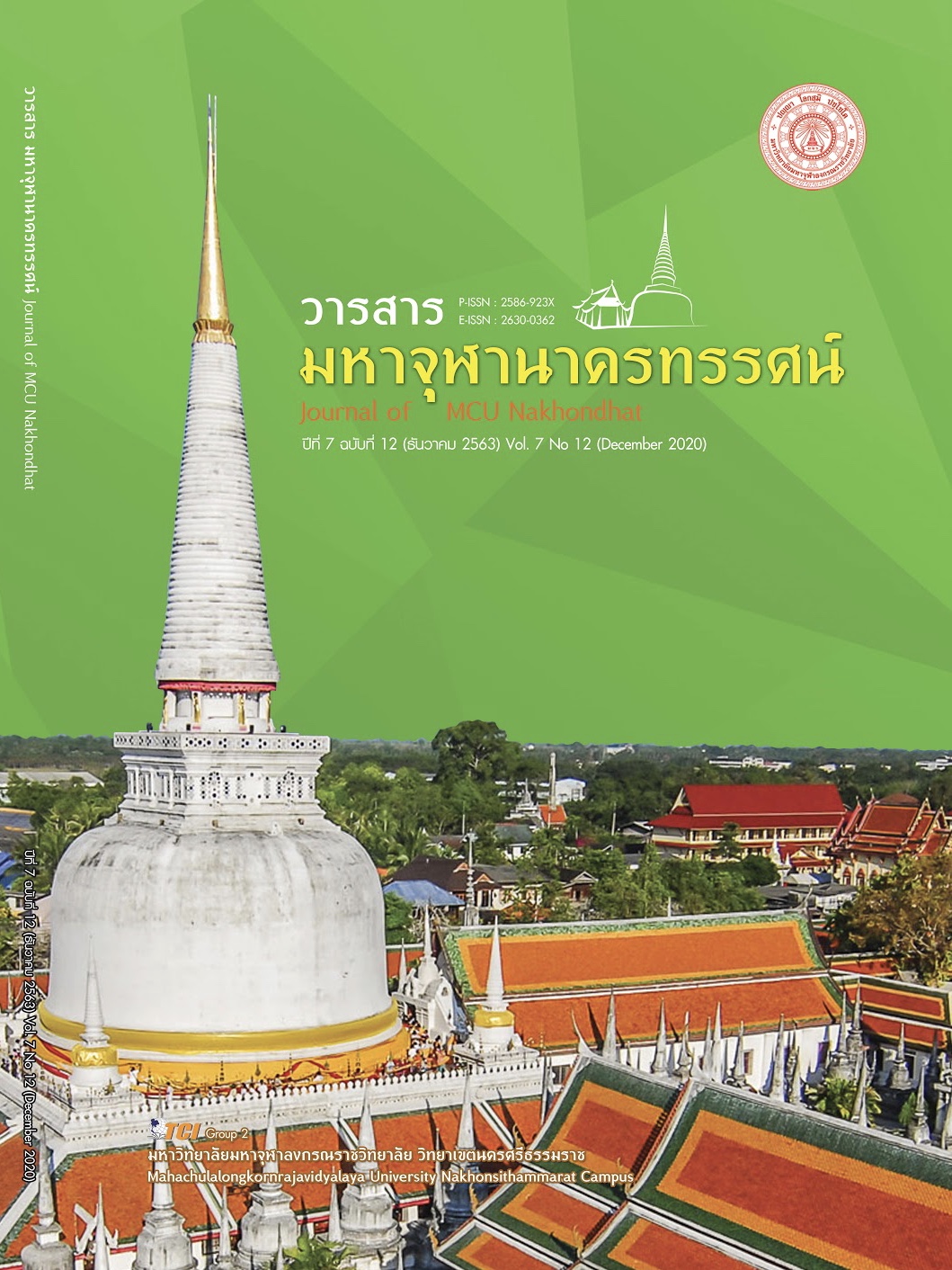SECONDARY CITY TOURIUM PROMOTION WITH DIGITAL MEDIA TECHNOLOGY
Main Article Content
Abstract
Thailand is a top tourist destination for foreign tourists. According to tourism, Thailand has identified the provinces that generate the main income from tourism. Divided into 22 main cities and 55 sub - cities, the secondary city is a unique city. It is an increasing attraction of both Thai and foreign tourists to visit the secondary city. Part of the growth of tourism Driven by the advancement of Internet of Things (IoT) That facilitates tourists Can search for information Book flight tickets, book rooms and pay more conveniently. For entrepreneurs Must create digital media in such a way that the entrepreneurs in the secondary cities come together in the same group of entrepreneurs. Service in the same area Or have specific expertise in the same subject as an online community It needs to create an appeal that is a deciding factor in travel. Description of properties The beauty of the attraction Also need to increase communication in terms of inspiration Will encourage tourists to decide to travel Internet of Things (IoT) must be developed as part of the tourists. To be the medium between the main needs of tourists and the harmony with the attractions As a result, tourists have the confidence to travel. Be impressed Comfort Good environment Sharing of information Sharing various experiences with each other, pictures of travel times with good feelings and beautiful scenery in the past, as well as creating tourism development, beneficial to decision making, have positive feelings on the use of digital media technology. Causing more behavior to use digital media technology for tourism management
Article Details
References
กระทรวงการท่องเที่ยวและกีฬา. (2558). ยุทธศาสตร์การท่องเที่ยวไทย พ.ศ. 2558 - 2560. เรียกใช้เมื่อ 29 กุมภาพันธ์ 2563 จาก http://www.mots.go.th/ewt_dl_link.php? nid=7114
กรุงเทพธุรกิจ. (2560). แพลตฟอร์มดิจิทัลเชื่อมโยงความสัมพันธ์’แบรนด์ - สังคม’. เรียกใช้เมื่อ 29 กุมภาพันธ์ 2563 จาก https://www.bangkokbiznews.com/news/detail /742372
กลุ่มสารสนเทศด้านเศรษฐกิจ. (2561). ดิจิทัลไทยแลนด์. เรียกใช้เมื่อ 28 กุมภาพันธ์ 2563 จาก http://service.nic.go.th/strategy.php?file strategy/policy-39
กองเศรษฐกิจการท่องเที่ยวและกีฬา. (2561). แผนพัฒนาเศรษฐกิจการท่องเที่ยวและกีฬา. เรียกใช้เมื่อ 28 กุมภาพันธ์ 2563 จาก https://secretary.mots.go.th/ewtadmin/ ewt/policy/group2.php
ซี หลี่ และธรรญธร ปัญญโสภณ. (2562). การใช้สื่อดิจิทัลของนักท่องเที่ยวชาวจีนกลุ่มมิลเลนเนียลที่ ตัดสินใจเดินทางท่องเที่ยวประเทศไทยในรูปแบบการท่องเที่ยวแบบอิสระ (Free Independent Traveler, FIT). รายงานการประชุม Graduate School Conference, 1(1), 249-258.
ณัฐกมล ถุงสุวรรณ. (2561). การใช้สื่อดิจิทัลคอนเทนต์กับการส่งเสริมการประสบการณ์เพื่อสร้างแรงบันดาลใจในการท่องเที่ยว. วารสารวิทยาการจัดการ มหาวิทยาลัยราชภัฎนครปฐม, 5(2), 189-200.
นจรี นิมิตกมลชัย และชลิสา กัลป์ยาณมิต. (2561). การท่องเที่ยวยุคดิจิทัลและนัยต่อรายรับภาคการท่องเที่ยวไทย. เรียกใช้เมื่อ 14 กมภาพันธ์ 2563 จาก https://www.bot. or.th/Thai/ResearchAndPublications/articles/Pages/Article_16Apr2019.aspx
ยุคลวัชร์ ภักดีจักริวุฒิ์ และเทิดชาย ช่วยบำรุง. (2562). ศักยภาพชุมชนด้านการส่งเสริมการตลาดการท่องเที่ยวแก่แหล่งท่องเที่ยว โดยชุมชนในพื้นที่พิเศษเมืองพัทยาและพื้นที่เชื่อมโยง. วารสารวิชาการนวัตกรรมสื่อสารสังคม, 7(2), 254-264.
ยุทธศักดิ์ สุภสร. (2562). ทิศทางท่องเที่ยวไทยในปี 2562. เรียกใช้เมื่อ 29 กุมภาพันธ์ 2563 จาก http://www.tatreviewmagazine.com/article/tourism-thailand-2562/
. (2563). การนำเสนอทิศทาง การส่งเสริมการท่องเที่ยว ของ ททท. ปี 2563. เรียกใช้เมื่อ 29 กุมภาพันธ์ 2563 จาก http://www.tatreviewmagazine.com/ article/tourism-direction-2020/
วลัยลักษณ์ อมรสิริพงศ์. (2562). การวิเคราะห์สถานการณ์ความ เหลื่อมล้ำทางดิจิทัล: ข้อเสนอเชิงนโยบาย เพื่อการบริหารจัดการของห้องสมุดประชาชน. วารสารวิชาการการตลาดและการจัดการ, 6(2), 97-113.
ศิริมา มิลอน. (2562). การนําเสนอสื่อสังคมออนไลน์ที่มีอิทธิพลต่อกลุ่มนักท่องเที่ยวที่เดินทางท่องเที่ยวญี่ปุ่นด้วยตัวเอง. ใน สารนิพนธ์นิเทศศาสตรมหาบัณฑิต สาขาวิชาการสื่อสารการตลาดดิจิทัล. มหาวิทยาลัยกรุงเทพ.
สำนักงานเลขาธิการสภาผู้แทนราษฎร. (2561). การท่องเที่ยวไทยในยุคดิจิทัล. เรียกใช้เมื่อ 28 กุมภาพันธ์ 2563 จาก https://library2.parliament.go.th/ejournal/content_af /2561/sep2561-4.pdf
สุปัญญดา สุนทรนนธ์. (2562). อิทธิพลของการรับรู้ถึงผลกระทบของนโยบาย การพัฒนาการท่องเที่ยวที่มีต่อผลการดำเนินงานของผู้ประกอบการวิสาหกิจขนาดกลางและขนาดย่อมในกลุ่มธุรกิจบริการที่พัก จังหวัดน่าน ประเทศไทย. วารสารบัณฑิตศึกษา มหาวิทยาลัยราชภัฏสกลนคร, 16(74), 1-10.
สุภาวรรณ์ นวลนิล. (2557). ประเภทของ Social Media. เรียกใช้เมื่อ 18 กุมภาพันธ์ 2563 จาก https://supawannuannil.wordpress.com/author/supawannuannil /page/2/
อาภาภัทร บุญรอด. (2560). ใช้สื่ออย่างไรให้ถูกใจแต่ละ “เจน”. เรียกใช้เมื่อ 2 มีนาคม 2563 จาก http://www.bangkokbiznews.com/blog/detail/643085
BTL BANGKOK. (2562). เมืองรองฮิต ติดเทรนด์เที่ยวปี 2020 ดันรายได้กระจายทั่วประเทศ. เรียกใช้เมื่อ 14 กุมภาพันธ์ 2563 จาก https://www.bltbangkok.com/news/ 5294/
JS100. (2018). เทรนด์เที่ยว “เมืองรอง” มาแรง ปีใหม่นี้ให้เมืองรองเป็นตัวเลือกกัน. เรียกใช้เมื่อ 29 กุมภาพันธ์ 2563 จาก https://today.line.me/th/pc/article/เทรนด์เที่ยว+‘เมืองรอง’+มาแรง+ปีใหม่นี้ให้เมืองรองเป็นตัวเลือกกัน-8wBe7n
PPTV Online. (2562). เทรนด์การท่องเที่ยวปี 2020 "เมืองรองมาแรง เที่ยวแบบสโลว์ไลฟ์ยังฮิต”. เรียกใช้เมื่อ 29 กุมภาพันธ์ 2563 จาก https://today.line.me/th/pc/article/เทรนด์การท่องเที่ยวปี+2020+เมืองรองมาแรง+เที่ยวแบบสโลว์ไลฟ์ยังฮิต-YYLjjN
TCIJ. (2560). คนไทยรู้ยัง: ปี 2559 นักท่องเที่ยวจีนยังมาเที่ยวไทยมากที่สุด. เรียกใช้เมื่อ 6 มกราคม 2563 จาก https://www.tcijthai.com/news/2017/31/scoop/6874


